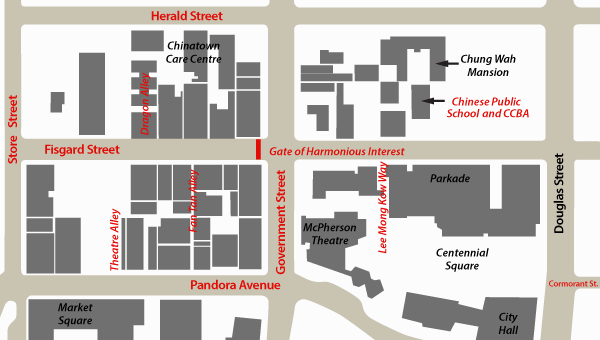- Home
- History
- Community
- Organizations
- Chinese Consolidated Benevolent Association
- Victoria Chinese Canadian Veterans Association
- Chinese Public School
- Clan Associations
- County Assocations
- Dialect Assocations
- Friendship Associations
- Political Organizations
- Recreational Associations
- Religious Organizations
- Women's Associations
- Other Organizations
- People
- Resources
- Contact
Fisgard Street
Commercial Centre of Present Chinatown
Fisgard Street, from Store to Government and up toward Douglas, is defined by a number of heritage buildings constructed from the late 1880s to the First World War as Chinatown expanded north from Cormorant Street. These multi-storey brick buildings served a variety of purposes: commercial space, housing, and organizational headquarters. A variety of goods and services have been available within walking distance to the neighbourhood’s residents, such as restaurants, herbalists, grocers, and stores selling imported goods. This street was the focus of an effort to revitalize Chinatown in the late 1970s and early 1980s, and the Gate of Harmonious Interest, spanning Fisgard at Government, has welcomed visitors to Chinatown since 1981.
On the south side of Fisgard, the Loo Tai Cho and Sheam and Lea buildings flank the entrance to Fan Tan Alley. Sheam Tip and Low Yan San built the first section of the Sheam and Lee Building in 1888. The property changed hands several times and was leased in 1901 by Lee Mong Kow, a government interpreter and educator who then built a western addition to this building. On your left as you enter Fan Tan Alley is a three storey building constructed by Loo Tai Cho in 1893. There is an entry way through the corner, and some of the upper windows open onto iron balconies.
Organizations have made their headquarters in various Fisgard Street buildings, for example the Chinese Canadian Cultural Association in the Lee Chong Building (built in 1901), and the Dart Coon Club and Chee Kung Tong in the Lee Woy’s Fisgard Building (built in 1908). A prominent structure on the north side of Fisgard is the three-storey CCBA Building, constructed in 1885 by the newly-formed Chinese Consolidated Benevolent Association. It originally included stores, the association’s office, the Chinese Free School and the Palace of Sages. To the east of Government Street, the Lee’s Benevolent Association built two narrow brick buildings in 1911 and sold the western building in 1935 to the Shon Yee Benevolent Association.
On the north side of Fisgard Street ca. 1939, the CCBA Building dominated the streetscape. To the left are the Tong Ork On Hing Building, the On Hing Building, and the Hart’s Fisgard Building (Royal BC Museum, BC Archives, I-20609). These heritage buildings are still present in 2012, with the George Joe Building to the right, constructed in 1946 the corner of Fisgard and Government. George Joe (Gar Nam Jong) hired David Cowper Frame, the architect who designed the Chinese Public School 1909, to build this restaurant to replace the earlier wood structure which was demolished in 1939 (Photo by Charles Yang, 2012).
Behind the street front buildings, opium factories operated in the late nineteenth century while they were legal, and by the early twentieth century, buildings intended for accommodation were constructed behind commercial spaces. These include the Quan Yuen Yen Building (1912) with an internal passageway, and the Gee Tuck Tong Rooming House (1913).
The Chinese Methodist Church and the Chinese Public School were also located on Fisgard. The Methodist Church was opened at 526 Fisgard Street in March 1891. This building was demolished in 1962 and there is now a parking lot in its place. The Chinese Public School was constructed by the CCBA in 1909 after the Victoria School Board barred Chinese-born children from attending public schools. More information about the building and the history of the school can be found elsewhere in this website.
To learn about additional heritage buildings on Fisgard Street, see David Chuenyan Lai’s The Forbidden City within Victoria (1991) and Canada’s Historic Places (http://www.historicplaces.ca/).
Sources
“George Joe Building.” Canada’s Historic Places.
http://www.historicplaces.ca/en/rep-reg/place-lieu.aspx?id=14892&pid=0 (accessed 4 October 2012).
Lai, David Chuenyan. The Forbidden City within Victoria: Myth, Symbol and Streetscape of Victoria’s Earliest Chinatown. Victoria: Orca Book Publishers, 1991.
“Sheam & Lee Building.” Canada’s Historic Places.
http://www.historicplaces.ca/en/rep-reg/place-lieu.aspx?id=14889&pid=0 (accessed 4 October 2012).


